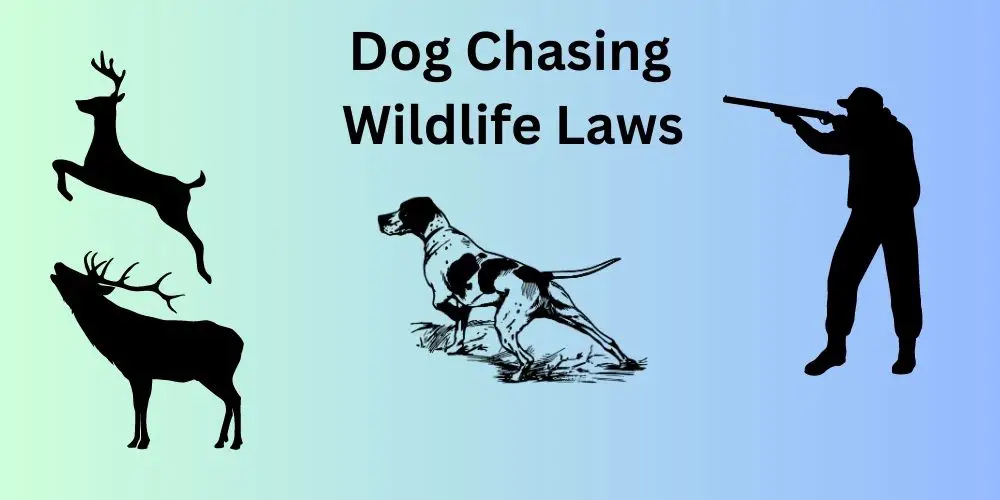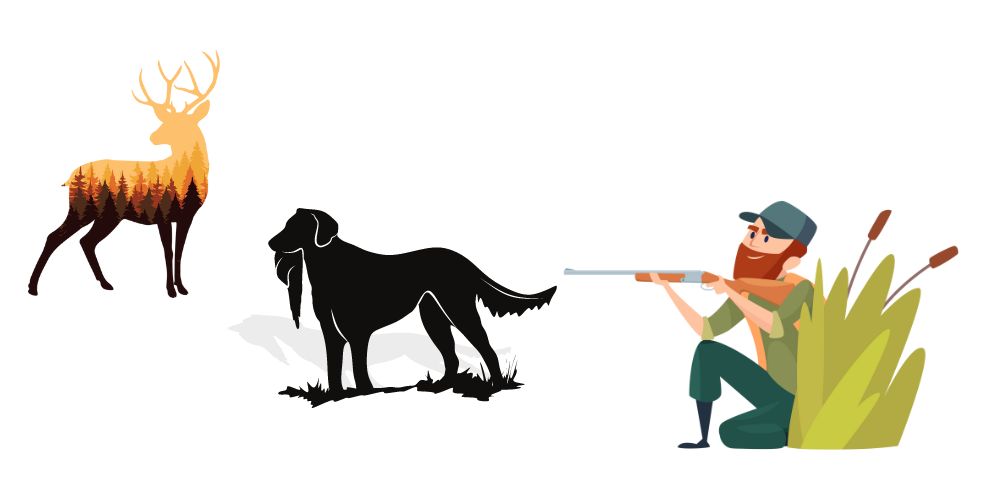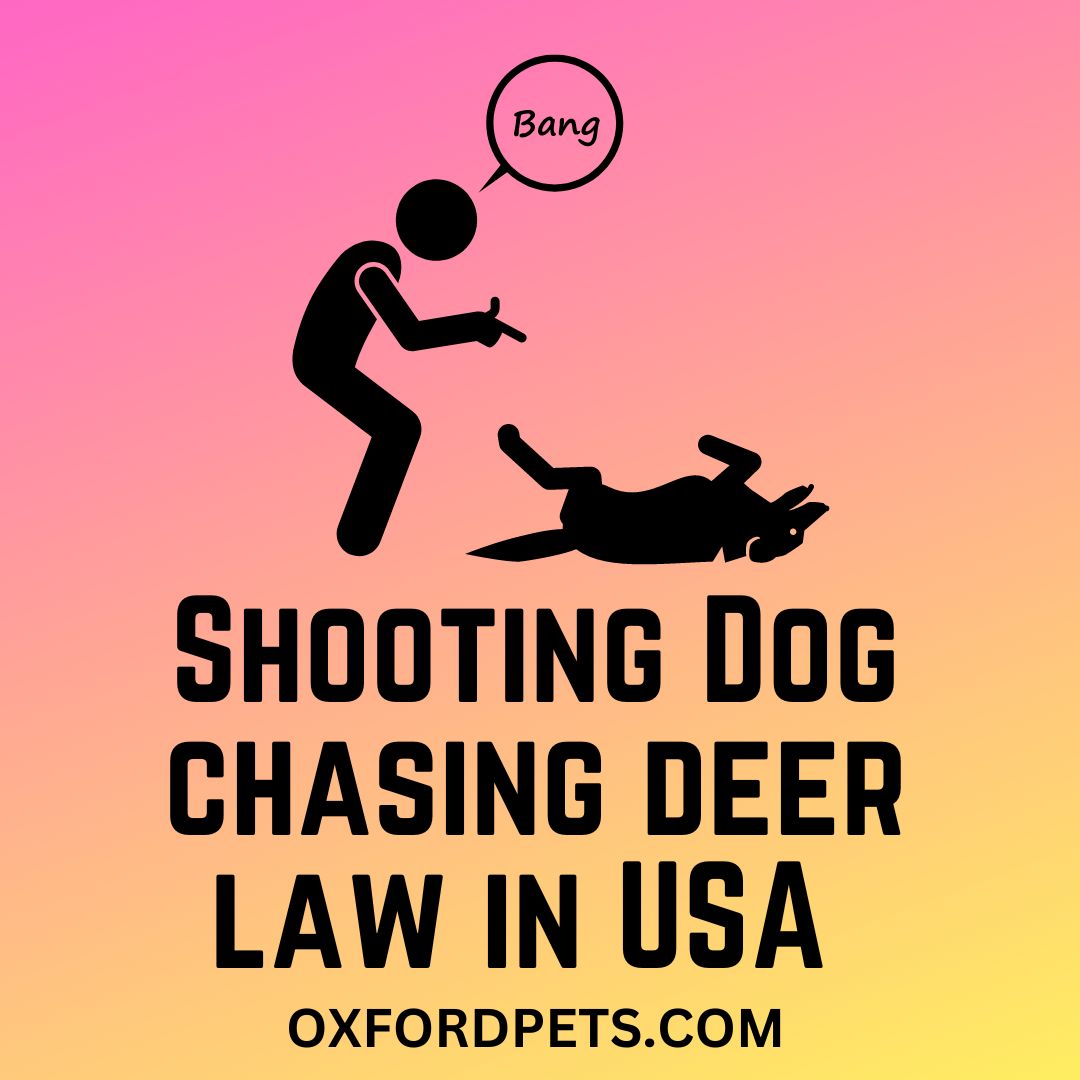Laws regarding shooting dogs that are chasing wildlife can vary by state and even within states by specific regulations in different areas. However, in general, it is illegal to shoot dogs that are chasing deer or moose in most states, as this can cause harm to both the dogs and the wildlife.
The laws regarding shooting dogs chasing deer or moose or wildlife vary depending on the state or country you are in. In some places, it may be legal to shoot dogs that are in the act of chasing or killing deer, while in others, it may be illegal.
In the United States, each state has its own laws regarding the use of firearms and hunting. Many states have laws that allow a person to kill a dog that is chasing or attacking livestock, but the laws can be different when it comes to wildlife. Some states may allow you to shoot a dog that is actively chasing or attacking deer, while others may require that you first attempt to contact the owner of the dog or contact a game warden before taking any action.
It is important to note that shooting a dog, even if it is chasing deer, should always be a last resort. Before taking any action, you should first try to contact the owner of the dog or a local animal control agency to report the situation. Additionally, if you feel threatened by the dog, you should contact your local law enforcement agency for assistance.
Contents
- 10 Reasons Why dogs chase deer or Moose?
- 10 Circumstances That Permits Dog Shooting While They Chase Animals
- What is Dog Chasing Deer Law?
- Table of US States that Allow and Prohibits Dog Shooting Chasing Wildlife
- How Do I Stop My Dog Chasing Deer?
- What is the Fine for Shooting Dogs In US States
- Dog Shooting Laws FAQ’S
- Summary
10 Reasons Why dogs chase deer or Moose?
Here are some possible reasons why dogs may chase deer or moose:
- Instinct: Dogs have a natural hunting instinct and chasing after prey like deer or moose can be an instinctual behavior.
- Excitement: Chasing animals can be an exciting and stimulating activity for dogs, especially breeds that were originally bred for hunting.
- Playfulness: Some dogs may chase deer or moose as a form of play, similar to how they might playfully chase after a ball or a toy.
- Lack of Exercise: Dogs that do not receive enough physical exercise may become bored and restless, and may turn to chasing after wildlife as a way to burn off energy.
- Lack of Training: Dogs that have not been trained properly may not understand that chasing deer or moose is not an acceptable behavior.
- Curiosity: Dogs are naturally curious animals and may simply be investigating the presence of a new or unfamiliar creature.
- Protection: Dogs may chase deer or moose in an attempt to protect their territory or their human family.
- Prey Drive: Some dogs have a strong prey drive and may be more likely to chase after animals like deer or moose.
- Boredom: Dogs that are left alone for long periods of time may become bored and restless, and may turn to chasing after wildlife as a way to entertain themselves.
- Lack of Supervision: Dogs that are not supervised properly may be more likely to chase after deer or moose, as they have more freedom to do so without their owner present to intervene.
10 Circumstances That Permits Dog Shooting While They Chase Animals
It is important to note that laws regarding shooting dogs that are chasing animals can vary by state and even within states by specific regulations in different areas. In general, shooting a dog should be considered a last resort and only used in circumstances where it is necessary to protect people or property. Here are some potential circumstances where shooting a dog that is chasing animals may be allowed:
- The dog is actively attacking or threatening people or livestock.
- The dog is causing significant property damage.
- The dog is chasing and attacking endangered species or other protected wildlife.
- The dog is posing an immediate threat to public safety.
- The dog has a history of aggression and has not responded to previous attempts to control its behavior.
- The dog is part of a pack of feral dogs that are causing significant damage to the environment or wildlife populations.
- The dog is causing a serious disruption to local ecosystems and wildlife habitats.
- The dog is posing a threat to critical infrastructure, such as power lines, water treatment plants, or transportation systems.
- The dog is infected with a dangerous disease, such as rabies, and poses a risk to public health and safety.
- The dog is causing a significant nuisance to local residents, and all other efforts to control its behavior have failed.
Again, it is important to check the specific laws and regulations in your area before taking any action to shoot a dog that is chasing animals. Shooting a dog should always be considered a last resort and done only when necessary to protect public safety or property.
What is Dog Chasing Deer Law?
The dog chasing deer law refers to regulations and laws that govern the chasing of deer by dogs. In some states and countries, it is illegal for dogs to chase deer, while in others, it may be legal but with certain restrictions.
The law may vary from place to place, but generally, it is illegal for dogs to chase deer during hunting season or in designated wildlife areas. The rationale behind this law is to protect wildlife and prevent unnecessary harm to animals.
Furthermore, some states and countries have specific regulations that allow landowners or hunters to take action against dogs that are caught in the act of chasing deer. This may include shooting the dog or reporting the incident to local authorities.
It is important to note that the dog chasing deer law can vary significantly depending on where you are. It is recommended to check with local authorities or wildlife agencies to understand the specific laws and regulations in your area.

Table of US States that Allow and Prohibits Dog Shooting Chasing Wildlife
| State | Shooting Dogs Chasing Wildlife Allowed? | Shooting Dogs Chasing Wildlife Prohibited? |
|---|---|---|
| Alabama | Yes | No |
| Alaska | Yes | No |
| Arizona | Yes | No |
| Arkansas | Yes | No |
| California | Yes, in limited circumstances | Yes |
| Colorado | No | Yes |
| Connecticut | Yes | No |
| Delaware | Yes, in limited circumstances | Yes |
| Florida | No | Yes |
| Georgia | Yes | No |
| Hawaii | Yes, in limited circumstances | Yes |
| Idaho | No | Yes |
| Illinois | Yes | No |
| Indiana | Yes | No |
| Iowa | Yes | No |
| Kansas | Yes | No |
| Kentucky | Yes | No |
| Louisiana | Yes | No |
| Maine | Yes | No |
| Maryland | Yes | No |
| Massachusetts | No | Yes |
| Michigan | Yes | No |
| Minnesota | Yes | No |
| Mississippi | Yes | No |
| Missouri | Yes | No |
| Montana | Yes | No |
| Nebraska | Yes | No |
| Nevada | No | Yes |
| New Hampshire | Yes | No |
| New Jersey | No | Yes |
| New Mexico | No | Yes |
| New York | Yes | No |
| North Carolina | Yes | No |
| North Dakota | Yes | No |
| Ohio | Yes | No |
| Oklahoma | Yes | No |
| Oregon | No | Yes |
| Pennsylvania | Yes | No |
| Rhode Island | Yes | No |
| South Carolina | Yes | No |
| South Dakota | Yes | No |
| Tennessee | Yes | No |
| Texas | Yes | No |
| Utah | No | Yes |
| Vermont | Yes | No |
| Virginia | Yes | No |
| Washington | No | Yes |
| West Virginia | Yes | No |
| Wisconsin | Yes | No |
| Wyoming | Yes | No |
However, in limited circumstances, such as if the dog is in the act of pursuing, worrying, or injuring livestock, some states may allow the shooting of dogs. It is essential to consult the specific state’s laws and regulations for the exact provisions and circumstances surrounding this issue.
How Do I Stop My Dog Chasing Deer?
Stopping a dog from chasing deer can be challenging, as dogs have a natural instinct to chase and hunt. However, there are some steps you can take to help train your dog and prevent them from chasing deer:
- Keep your dog on a leash: This is the most effective way to prevent your dog from chasing deer. By keeping your dog on a leash, you have better control over their movements and can prevent them from running off after wildlife.
- Train your dog to respond to commands: Teaching your dog basic obedience commands, such as “come,” “stay,” and “leave it,” can help you redirect their attention and prevent them from chasing deer. Practice these commands regularly with positive reinforcement training.
- Use deterrents: Consider using deterrents such as a whistle or an air horn to interrupt your dog’s behavior when they start to chase deer. These can startle your dog and distract them from the deer.
- Provide enough exercise and mental stimulation: Dogs may be more likely to chase deer if they are bored or have excess energy. Make sure your dog is getting enough exercise and mental stimulation through activities such as walks, hikes, and games.
- Use positive reinforcement: When your dog behaves well and does not chase deer, reward them with praise, treats, and affection. Positive reinforcement can help reinforce good behavior and make it more likely that your dog will repeat it in the future.
It’s important to note that training a dog not to chase deer can take time and patience. Consistency is key, so be sure to practice these techniques regularly and remain calm and patient with your dog.

What is the Fine for Shooting Dogs In US States
The fines for shooting dogs in the USA will vary depending on the state and the circumstances of the incident. Shooting a dog can be considered a serious offense in some cases and may result in criminal charges or civil penalties. Here are some examples of fines for shooting dogs in certain states:
- Alabama: It is legal to shoot dogs that are chasing or attacking livestock or game animals. There are no specific fines associated with this law.
- California: Shooting a dog is illegal except in situations where the dog poses an immediate threat to human life or safety. Violations of this law can result in criminal charges and fines of up to $20,000.
- Georgia: It is legal to shoot dogs that are chasing or attacking livestock or game animals. There are no specific fines associated with this law.
- Michigan: It is legal to shoot a dog that is chasing or attacking livestock or game animals. Violations of this law can result in criminal charges and fines of up to $2,500.
- New York: It is legal to shoot dogs that are chasing or attacking livestock or game animals. There are no specific fines associated with this law.
- Texas: It is legal to shoot dogs that are attacking livestock, domestic animals, or game animals. Violations of this law can result in criminal charges and fines of up to $10,000.
Again, it’s essential to remember that shooting a dog should be a last resort and only done in situations where it is legal and necessary to protect human life, livestock, or other animals. Before taking any action, it is important to contact the local authorities and follow the appropriate procedures for handling the situation.
Dog Shooting Laws FAQ’S
Q: Can you shoot a dog chasing deer in Texas?
A: Shooting dogs chasing deer or other wildlife is generally prohibited in Texas, as in many other states. However, there are limited exceptions for dogs that are actively attacking livestock.
Q: Can you shoot a dog chasing deer in Michigan?
A: No, shooting dogs chasing deer or other wildlife is prohibited in Michigan, except in situations where the dog is threatening or attacking livestock.
Q: Can you shoot a dog chasing deer in Vermont?
A: No, shooting dogs chasing deer or other wildlife is prohibited in Vermont, except in certain circumstances where the dog poses an imminent threat to public safety.
Q: Can you shoot a dog chasing deer in Minnesota?
A: No, shooting dogs chasing deer or other wildlife is prohibited in Minnesota, except in cases where the dog is actively attacking or harassing livestock.
Q: Can you shoot a dog chasing deer in Colorado?
A: No, shooting dogs chasing deer or other wildlife is prohibited in Colorado, except in cases where the dog is threatening or attacking livestock.
Q: Can you shoot a dog chasing deer in Pennsylvania?
A: No, shooting dogs chasing deer or other wildlife is prohibited in Pennsylvania, except in situations where the dog is posing an imminent threat to public safety or is attacking livestock.
Summary
In conclusion, shooting dogs chasing deer or other wildlife is generally prohibited in most states in the US, including Texas, Michigan, Vermont, Minnesota, Colorado, and Pennsylvania. However, there are some exceptions where the dog may be posing a threat to public safety or actively attacking livestock.
It is crucial to consult the specific state laws and regulations for the exact provisions and circumstances surrounding this issue. In any case, responsible pet ownership and proper dog training can prevent such incidents from occurring in the first place.
Additionally, it is important to prioritize the safety of both the dog and the deer when making any decisions about how to handle the situation.
